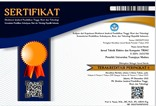Smart Digital Measurement System for Rural Water Quality Monitoring Using IoT
Abstract
Keywords
Full Text:
PDFReferences
R. Martínez, N. Vela, A. el Aatik, E. Murray, P. Roche, and J. M. Navarro, “On the use of an IoT integrated system for water quality monitoring and management in wastewater treatment plants,” Water (Switzerland), vol. 12, no. 4, 2020, doi: 10.3390/W12041096.
S. L. Chen et al., “An Intelligent Water Monitoring IoT System for Ecological Environment and Smart Cities,” Sensors (Basel)., vol. 23, no. 20, 2023, doi: 10.3390/s23208540.
J. Kumar, R. Gupta, S. Sharma, T. Chakrabarti, P. Chakrabarti, and M. Margala, “IoT-Enabled Advanced Water Quality Monitoring System for Pond Management and Environmental Conservation,” IEEE Access, vol. 12, no. April, pp. 58156–58167, 2024, doi: 10.1109/ACCESS.2024.3391807.
C. Z. Zulkifli et al., “IoT-Based Water Monitoring Systems: A Systematic Review,” Water (Switzerland), vol. 14, no. 22, 2022, doi: 10.3390/w14223621.
N. A. Razman, W. Z. W. Ismail, M. H. A. Razak, I. Ismail, and J. Jamaludin, “Design and analysis of water quality monitoring and filtration system for different types of water in Malaysia,” Int. J. Environ. Sci. Technol., vol. 20, no. 4, pp. 3789–3800, 2023, doi: 10.1007/s13762-022-04192-x.
H. M. Forhad et al., “IoT based real-time water quality monitoring system in water treatment plants (WTPs),” Heliyon, vol. 10, no. 23, p. e40746, 2024, doi: 10.1016/j.heliyon.2024.e40746.
A. T. Chafa, G. P. Chirinda, and S. Matope, “Design of a real–time water quality monitoring and control system using Internet of Things (IoT),” Cogent Eng., vol. 9, no. 1, 2022, doi: 10.1080/23311916.2022.2143054.
P. Boccadoro, V. Daniele, P. Di Gennaro, D. Lofù, and P. Tedeschi, “Water quality prediction on a Sigfox-compliant IoT device: The road ahead of WaterS,” Ad Hoc Networks, vol. 126, pp. 1–13, 2022, doi: 10.1016/j.adhoc.2021.102749.
I. Essamlali, H. Nhaila, and M. El Khaili, “Advances in machine learning and IoT for water quality monitoring: A comprehensive review,” Heliyon, vol. 10, no. 6, p. e27920, 2024, doi: 10.1016/j.heliyon.2024.e27920.
F. Jan, N. Min-Allah, and D. Düştegör, “Iot based smart water quality monitoring: Recent techniques, trends and challenges for domestic applications,” Water (Switzerland), vol. 13, no. 13, pp. 1–37, 2021, doi: 10.3390/w13131729.
A. Fornika Sari, S. Darmawan Panjaitan, B. Wibowo Sanjaya, M. Saleh, and H. Priyatman, “Development of Advanced Monitoring System for IoT-based Raw Water Quality Prediction,” J. Electr. Eng. Energy, Inf. Technol. (J3EIT, vol. 12, no. 2, pp. 376–384, 2024, doi: 10.26418/j3eit.v12i2.77221.
W. A. Jabbar et al., “Development of LoRaWAN-based IoT system for water quality monitoring in rural areas,” Expert Syst. Appl., vol. 242, no. December 2023, p. 122862, 2024, doi: 10.1016/j.eswa.2023.122862.
D. Kurniawan and A. L. Afifudin, “Pengembangan Sistem Informasi Monitoring Kualitas Air Berbasis IoT untuk Pengelolaan Sanitasi Pondok Pesantren,” J. Inform. dan Teknol. Komput., vol. 5, no. 2, pp. 170–176, 2025, doi: : https://doi.org/10.55606/jitek.v5i2.3223.
A. H. Kelechi et al., “Design and Implementation of a Low-Cost Portable Water Quality Monitoring System,” Comput. Mater. Contin., vol. 69, no. 2, pp. 2405–2424, 2021, doi: 10.32604/cmc.2021.018686.
W. H. O, “Call for experts to serve as members of an expert advisory group: Guidelines for drinking-water quality: 5th edition,” 2024.
DOI: https://doi.org/10.21107/triac.v12i2.32139
Refbacks
- There are currently no refbacks.
Copyright (c) 2025 Jurnal Teknik Elektro dan Komputer TRIAC

This work is licensed under a Creative Commons Attribution-ShareAlike 4.0 International License.

 .
.











